Human Orbital Spaceflights
![]()
International Flight No. 63Soyuz 28ZenitUSSR |
 |
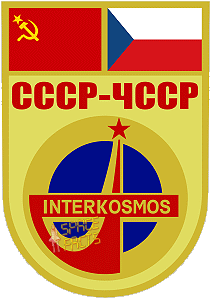 |
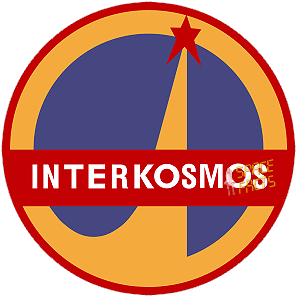 |
||
![]()
Launch, orbit and landing data
walkout photo |
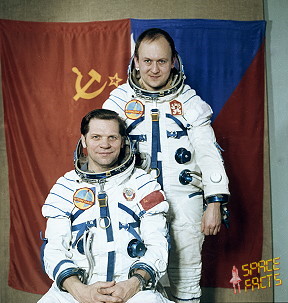 |
|||||||||||||||||||||||
alternative crew photo |
alternative crew photo |
|||||||||||||||||||||||
alternative crew photo |
alternative crew photo |
|||||||||||||||||||||||
alternative crew photo |
alternative crew photo |
|||||||||||||||||||||||
Crew
| No. | Surname | Given names | Position | Flight No. | Duration | Orbits | |
| 1 | Gubarev | Aleksei Aleksandrovich | Commander | 2 | 7d 22h 16m 00s | 125 | |
| 2 | Remek | Vladimír "Volodya" | Research Cosmonaut | 1 | 7d 22h 16m 00s | 125 |
Crew seating arrangement
|
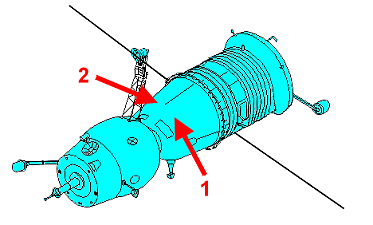 |
|
||||||||||||
Backup Crew
|
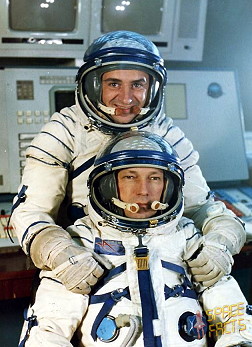 |
|||||||||||||||
alternative crew photo |
||||||||||||||||
alternative crew photo |
||||||||||||||||
alternative crew photo |
||||||||||||||||
alternative crew photo |
||||||||||||||||
alternative crew photo |
Hardware
| Launch vehicle: | Soyuz-U (No. D15000-132) |
| Spacecraft: | Soyuz 28 (7K-T No. 45) |
Flight
|
Launch from the Baikonur Cosmodrome and
landing 140 km north of Arkalyk. The launch was delayed three days of
unspecified cause. Soyuz 28 marked the first Intercosmos mission with a foreign cosmonaut on board. The Czechoslovakian Vladimir Remek became the first cosmonaut of his country. Aleksei Gubarev and Vladimir Remek, the first non-Soviet, non-American to travel to space, were launched aboard Soyuz 28 on March 02, 1978, after a three-day delay of unspecified cause. Following a one-day solo flight Soyuz 28 docked with the Salyut 6 space station on March 03, 1978. The visiting cosmonauts were greeted by the first resident crew Georgi Grechko and Yuri Romanenko who had arrived on Soyuz 26 in December 1977. Aleksei Gubarev and Georgi Grechko had previously flown together on Soyuz 17 to the Salyut 4 space station in 1975. The docking with Salyut 6 took place on March 03, 1978 at 17:09 UTC, with Aleksei Gubarev docking at the unoccupied aft aperture - the forward docking port was already occupied by the Soyuz 27 craft. The visiting cosmonauts brought with them letters, newspapers, and magazines for the resident crew. Intercosmos missions had mainly political purposes but also some scientific experiments were performed, including one which monitored the growth of Chlorella seaweed in zero gravity, another which used the on-board Splav furnace to melt glass, lead, silver and copper chlorides, and an experiment called Oxymeter which measured oxygen in human tissue. Vladimir Remek's experiment program touched on life sciences, materials processing, and upper atmosphere research. The experiments performed by both crews included: Khlorella-1 (Chlorella, or green freshwater algae): A study of the effects of microgravity on the growth of unicellular algae, which served as a model for fast-growing organisms. All the samples were carried in soldered ampoules stored in four containers with a nutrient medium. The aim of the experiment was to learn more about the future use of algae in air and water recycling systems aboard spacecraft. It was determined that microgravity does not affect the speed at which algae populations grow. Morova-Splav and Morava-Kristall (Morova is a river in Czechoslovakia; "splav" means "alloy"): A series of materials-processing experiments with the aim of obtaining materials in space that cannot be obtained on Earth. The experiments, prepared jointly by the Solid Body Physics Institute of the Czechoslovakian Academy of Sciences and the Institute of Space Research in Moscow, studied the solidification of melted crystalline and glassy materials and the growth of crystals from the gas phase. Kislorod (Oxygen): An experiment to study any changes in the supply of oxygen to various parts of the human tissue during flight and to see how human tissue uses oxygen in microgravity. The experiment was carried out with a portable Czech-built device called Oximeter, consisting of an array of special sensors. Oprosnik (Questionnaire): Twice during the flight the cosmonauts filled out a questionnaire on their medical and psychological condition. The questions related to such things as the cosmonauts' food and water consumption, sleep patterns, eyesight, sense of smell, ability to hear and aesthetic requirements, which they had to assess on a scale of five. Jointly developed by Soviet, Czech and Polish specialists, this experiment was designed to help determine how people adapt to the unusual conditions of spaceflight, and to further improve living and working conditions in confined spaces. Teploobmen-2 (Heat Exchange 2): An experiment designed to study the cooling effects of the space station's atmosphere. The cooling of objects that produce heat significantly changes in zero-g as one of the main elements of heat exchange - namely heat emission through natural convection - is missing. Ekstinktsia (Extinction): The crew visually observed how the brightness of stars changed as they disappeared behind the horizon. Earlier Soviet and American crews had noticed that stars begin fading when they are still about 100 km from the horizon. At the time, no satisfactory explanation had been found for this phenomenon. The cosmonauts' task was to determine changes in the magnitude, color and scintillation of stars as they approached the horizon, which would help develop a photometer to carry out similar observations on future missions. Such a photometer was being developed at the time by the Astronomical Institute of the Czechoslovak Academy of Sciences in Ondrejov. On March 10, 1978, the Soyuz 28 crew prepared for their return to Earth, packing experiments and testing systems. They returned silver chloride capsules and copper and lead chloride samples from the Salyut 6 materials experiments. The cosmonauts undocked from the station and landed 135 km north of Arkalyk later that day. The Soyuz spacecraft is composed of three elements attached end-to-end - the Orbital Module, the Descent Module and the Instrumentation/Propulsion Module. The crew occupied the central element, the Descent Module. The other two modules are jettisoned prior to re-entry. They burn up in the atmosphere, so only the Descent Module returned to Earth. The deorbit burn lasted 188 seconds. Having shed two-thirds of its mass, the Soyuz reached Entry Interface - a point 400,000 feet (121.9 kilometers) above the Earth, where friction due to the thickening atmosphere began to heat its outer surfaces. With only 23 minutes left before it lands on the grassy plains of central Asia, attention in the module turned to slowing its rate of descent. Eight minutes later, the spacecraft was streaking through the sky at a rate of 755 feet (230 meters) per second. Before it touched down, its speed slowed to only 5 feet (1.5 meter) per second, and it lands at an even lower speed than that. Several onboard features ensure that the vehicle and crew land safely and in relative comfort. Four parachutes, deployed 15 minutes before landing, dramatically slowed the vehicle's rate of descent. Two pilot parachutes were the first to be released, and a drogue chute attached to the second one followed immediately after. The drogue, measuring 24 square meters (258 square feet) in area, slowed the rate of descent from 755 feet (230 meters) per second to 262 feet (80 meters) per second. The main parachute was the last to emerge. It is the largest chute, with a surface area of 10,764 square feet (1,000 square meters). Its harnesses shifted the vehicle's attitude to a 30-degree angle relative to the ground, dissipating heat, and then shifted it again to a straight vertical descent prior to landing. The main chute slowed the Soyuz to a descent rate of only 24 feet (7.3 meters) per second, which is still too fast for a comfortable landing. One second before touchdown, two sets of three small engines on the bottom of the vehicle fired, slowing the vehicle to soften the landing. |
Photos / Graphics
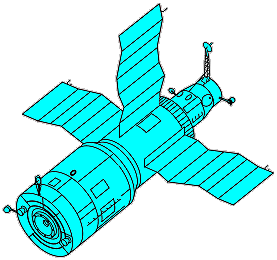 |
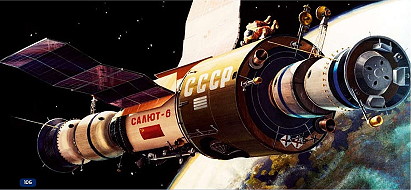 |
 |
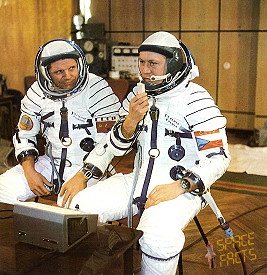 |
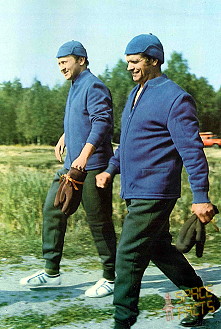 |
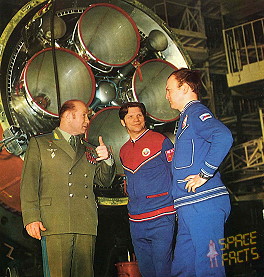 |
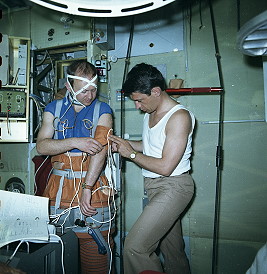 |
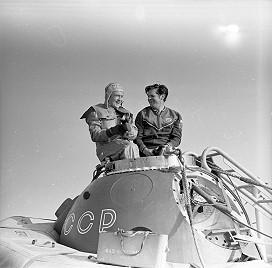 |
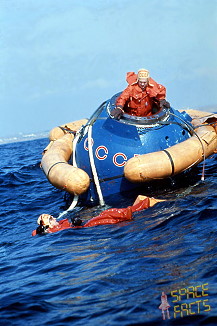 |
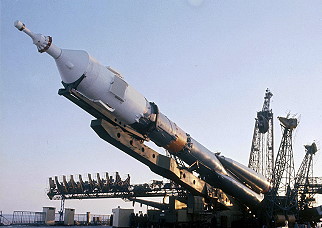 |
 |
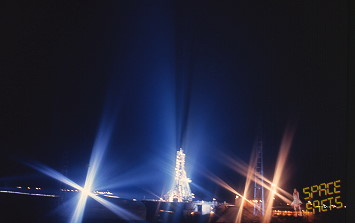 |
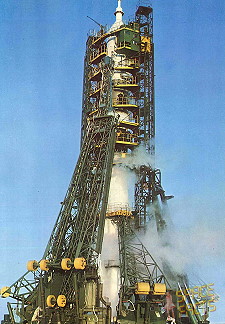 |
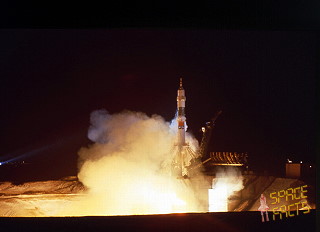 |
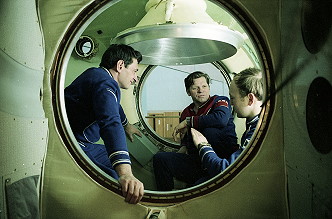 |
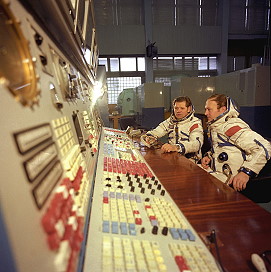 |
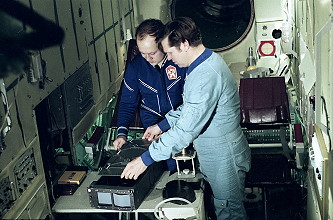 |
 |
 |
 |
 |
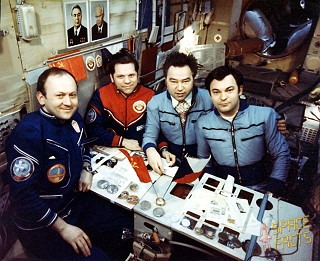 |
 |
 |
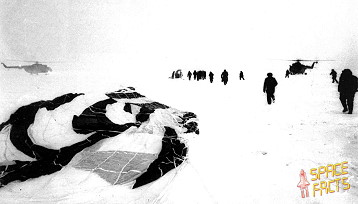 |
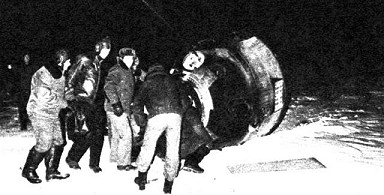 |
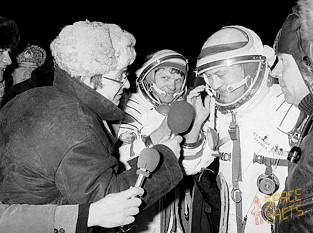 |
| © |  |
Last update on March 27, 2025.  |
 |